Working memory
Memory anatomy
Search CIDPUSA WEBSITE
😏
AUTOIMMUNE EPIDEMICFriday, 24 June 2005
What is declerative memory?
Neurotransmitter
The Brain
Spinal Cord
Peripheral Nervous System
Autonomic Nervous System
Senses:
Sight,
Senses,
Smell,
Taste,
Senses,
Senses
Memory
Higher Functions
Altered States
- Declarative Memory
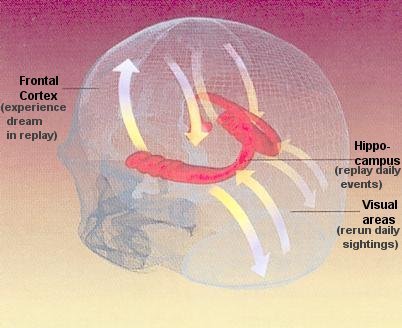
Declarative memory - Declarative memory covers the memory of facts such as events and names, which do not need to be repeated for them to sink in. Those experiences destined to be laid down as long-term memories are shunted down to thehippocampus where they are held in storage for 2 - 3 years. During this time the hippocampus replays the experiences back up to the cortex, and each rehearsal etches it deeper into the cortex. Eventually the memories are so firmly established in the cortex that the hippocampus is no longer needed for their retrieval. Much of the hippocampal replay is thought to happen during sleep.Dreams consist partly of a rerun of things that have happened during the day, fired up to the cortex by the hippocampus. The visual areas generate rerun of daily sightings (Figure27).
Figure 27 Long-term Memory
[view large image] Semantic, and episodic memory are the subclasses of declarative memory:
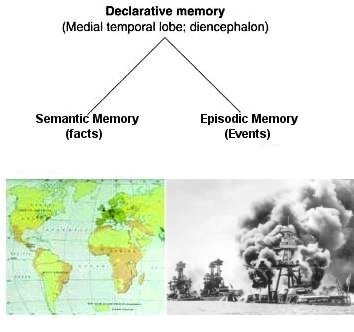
- Episodic memory
- It is about an event in one's life and everything about it, including emotional reactions. Remembering an episode, e.g., the attack on Pearl Harbour (Figure 28), is to create a memory for a unique event that only happened once and there is no opportunity for learning the event by rehearsal. Episodic memories are not very reliable, they are highly personal, selective, idiosyncratic and varying over time, but they may also be richly complex and movie-like in character. They constitute the stories we tell ourselves about our past, they are the things we would write about in our autobiography. Episodic memories can be recalled deliberately or are triggered by evocative sensory stimuli - particularly by the sense of
Figure 28 Declarative Memory
[view large image]
smell. Episodic memory involves the use of the hippocampus for forming memories and the cortex for storage (see diagram D, Figure 24).- Semantic memory - Semantic memory is the knowledge of facts - numbers, addresses, language and concepts - which the brain files in categories and which seems to involve the left temporal lobe. Retrieval is then carried out by the frontal lobes (see diagram E, Figure 24). We assume all of the facts that constitute our knowledge of things must be stored in an organized fashion to be useful. Though this has not been demonstrated, it seems likely that the brain stores our semantic memories as modules that have some logical links to one another; they are grouped by category for instance. On retrieval, the brain knows where to find the memory according to the address of that particular category. Semantic memory is essential to the understanding of how things work and thus to an under-standing of the world we live in. It is a body of knowledge that helps us to regulate our behaviour according to and dependent on reliable factual memories. Navigational skills, for example, depend on our ability to deploy a complex store of semantic memory, including detailed spatial memories and representations of the world.
Memory is created by association between a group of neurons such that when one fires, they all fire, producing a specific pattern. Thought, sensory perceptions, ideas, and hallucinations - any brain function is made up of this same thing. For example, a group of neighbouring neurons firing together in the auditory cortex would bring about the experience of a certain note of music. A memory is a pattern like these. The only difference is that it remains encoded in the brain after the stimulation that originally gave rise it has ceased. Memories form when a pattern is repeated frequently, or in circumstances that encourage it to be encoded. This is because each time a group of neurons fires together the tendency to do so again is increased. Once the neighbour has been triggered to fire a chemical change takes place on its surface which leaves it more sensitive to stimulation from that same neighbour. This process is called long-term potentiation (LTP). If the neighbour cell is not stimulated again it will stay in this state of readiness for hours, maybe days. If the first cell fires again during this period, the neighbour may respond even if the firing rate of cell number one relatively slow. A second firing makes it even more receptive and so on. Eventually, repeated synchronous firing binds neurons together so that the slightest activity in one will trigger all those that have become associated with it to fire, too. A memory has been formed.
The giant sea slug called Aplysia californica¶ is often chosen for the studying of memory. Its brain has about 20000 neurons, some of which are large enough to be visible to the naked eye. Aplysia can learn and most importantly it is found that the
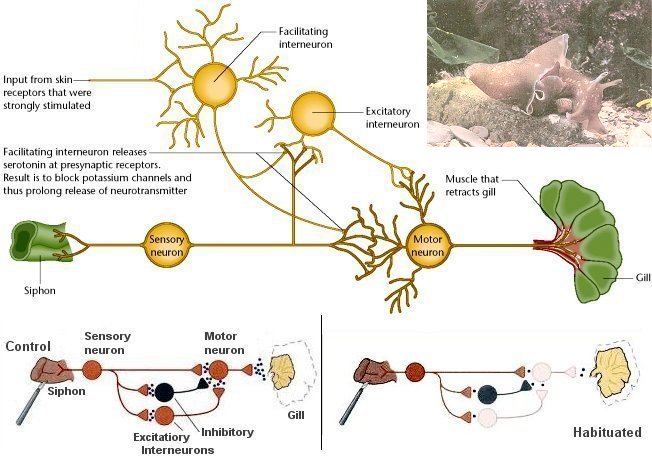 mechanisms and principles involved in its formation of short- and long-term memories are conserved throughout the animal kingdom, including in humans. Aplysia exhibits a behaviour of protective reflex in which the sea slug withdraws its gill into the safety of the mantel cavity in response to a mild touch stimulus to another part of the body called the siphon (Figure 29a). If the stimulus is repeated a number of times, the gill withdrawal reflex becomes weaker until finally the animal ignores the touch stimulus. The waning of sensitivity to repeated stimulation is known as habituation and is a very simple form of learning found in all animals, including humans. Another type of learning is sensitization, when we are exposed to an unexpected or strongly unpleasant stimulus. Generally the sensitizing effect of
mechanisms and principles involved in its formation of short- and long-term memories are conserved throughout the animal kingdom, including in humans. Aplysia exhibits a behaviour of protective reflex in which the sea slug withdraws its gill into the safety of the mantel cavity in response to a mild touch stimulus to another part of the body called the siphon (Figure 29a). If the stimulus is repeated a number of times, the gill withdrawal reflex becomes weaker until finally the animal ignores the touch stimulus. The waning of sensitivity to repeated stimulation is known as habituation and is a very simple form of learning found in all animals, including humans. Another type of learning is sensitization, when we are exposed to an unexpected or strongly unpleasant stimulus. Generally the sensitizing effect of Figure 29a Memory in Aplysia
[view large image]
a single alarming stimulus is short-lived, lasting perhaps for just a few minutes. But if the alarming stimulus is repeated a number of times our senses may be heightened for days and now such sensitization becomes a form of long-term memory.It turns out that short term changes involves only modification of pre existing proteins and alterations of pre existing connections. The short term process does not involve ongoing macromolecule synthesis. The effect wears off with time or repeated applications with no untoward happening. On the other hand, long term process involves a structural change which is not seen in the short term. In long term processes, there is a growth in new synaptic connections by sensory neurons onto follower cells. The growth of new synaptic connections is activated by the gene expression resulting in new protein synthesis.
At the macromolecule level, it is known that the neurotransmitter involved in the processes is the serotonin. A puff of serotonin alone can substitute for the siphon shock. It is shown further that the serotonin triggers the release of the second chemical messenger calledcyclic-AMP. It activates an important type of enzyme called a kinase, which modifies the properties of particular target proteins by adding a phosphate molecule to them; the term for this is protein phosphorylation. The target for this modification in the sensory neuron is a potassium channel protein. It is mentioned earlier that a potassium channel is important in the downward phase of the action potential. The net result of phosphorylation is a prolongation of the action potential in the sensory neuron and so more neurotransmitter is released by the sensory neuron. Thus the sensory neuron's synapse with the gill motor neuron is strengthened. In short-term memory, special enzymes quickly remove phosphates from the proteins and return them to their original state, restoring the synaptic strength to its lower pre-sensitized level. However, following repeated serotonin delivery, the level of cAMP-activated kinase is much higher and this allows the crucial step in the formation of long-term memory to occur. This crucial step is the transport from the synapse to the cell body of kinase molecules that have been activated by c-AMP. Once in the cell body the activated kinases enter the nucleus and start to regulate the expression of particular genes. In Aplysia, proteins that result from this process of gene activation are transported back to the synapse where they are used to maintain the strength of synapses already affected by local effects of c-AMP and to grow new synaptic connections. So in Aplysia (as in other animals) the conversion of a short-term into a long-term memory involves the reinforcement of the short-term changes in synaptic strength and the growth of new synapses, both of which require the synthesis of new proteins.
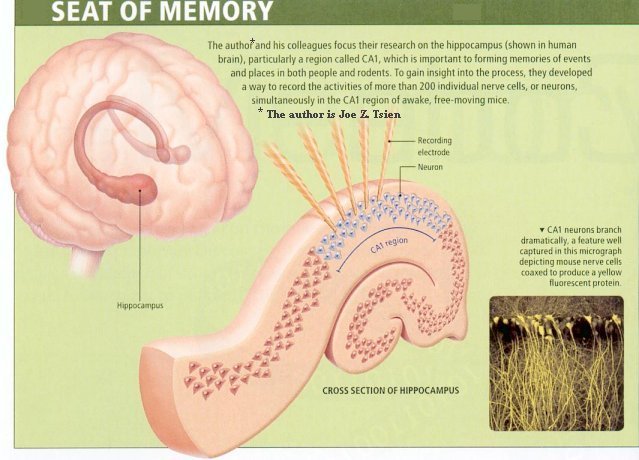
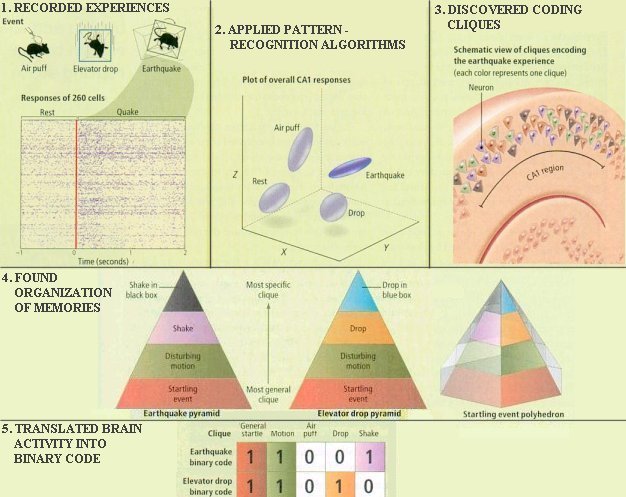 It is reported in 2007 that the seat of memory has been pinpointed in mouse. By monitoring 260 neurons in the hippocampus (Figure 29b), researchers have discovered that different experience is recorded in different area called "clique", which can be categorized from very general to very specific. Furthermore, such brain activities can be translated into binary codes (Figure 29c). Supposedly, we can read the mind from such codes and tell what it is
It is reported in 2007 that the seat of memory has been pinpointed in mouse. By monitoring 260 neurons in the hippocampus (Figure 29b), researchers have discovered that different experience is recorded in different area called "clique", which can be categorized from very general to very specific. Furthermore, such brain activities can be translated into binary codes (Figure 29c). Supposedly, we can read the mind from such codes and tell what it is Figure 29b Seat of Memory
[view large image]
Figure 29c Memory Code
[view large image]
thinking by the process of backward translation. The followings are steps to uncover the memory code:- Recorded Experiences - The mice are exposed to three startling experiences - a puff of air on the back (to mimic an owl attack from the sky), a fall in a container (the "elevator" drop), and shaking in a cage (the "earthquake") - while a recorded plotted firing from a large set of CA1 neurons. Each row in the plot captures firing of a single cell over time.
- Patterns of Mental Activities - The points in the 520 dimensional phase space (corresponding to the activities of 260 neurons before and after an event) are projected into a 3 dimensional phase space. Different mental activity falls into different area in such plot starting from "rest". Temporal analysis revealed that the activity patterns associated with those startling experiences recurred spontaneously at intervals ranging from seconds to minutes after the actual event, but with smaller amplitudes than the original response. Such patterns provide evidence that the information traveling through the hippocampal system was inscribed into the brain's memory circuits. The replay corresponds to a recollection of the experience after the fact.
- Coding Cliques - It is discovered that neuron ensembles active during an event contain subsets -termed neural cliques. The cells in a clique all show very similar firing patterns and are not part of the other cliques.
- Organization of Memories - Further analyses showed that each clique encodes a different aspect of an experience, ranging from the general to the specific. It can be visualized as a hierarchical organization with the most general clique at bottom, and the very specific on top. Any given pyramid can be a component of a more general polyhedron representing all events of a given category, such as "all startling events".
- Translated into Binary Code - The clique activity is represented as a string of binary code with 1 as being active and 0 signifies inactivity. Thus the earthquake binary code is 11001 corresponding to: "starting event", "disturbing motion", "air puff", "drop", and "shake". While the elevator drop binary code is 11010 for the same sequence.